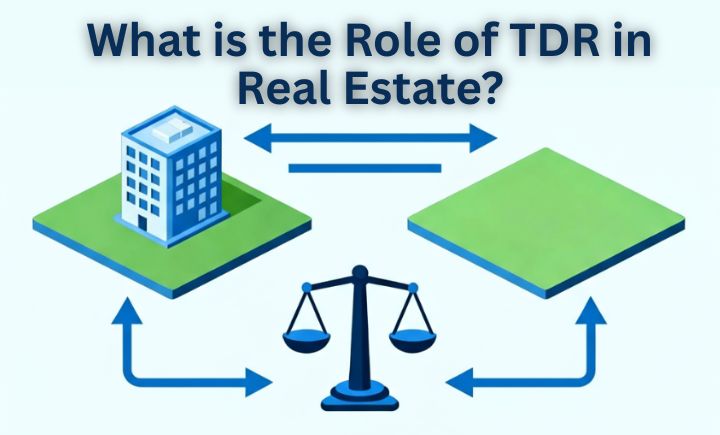
Register here and Avail the Best Offers!!
 +91-999 9111 100
+91-999 9111 100 
 By Buniyad
By Buniyad 11/03/2025
Real Estate is more than just buying and selling of residential and commercial properties. There are many terms and schemes the knowledge of which can help various parties save money and resources both. One such term is TDR – Transferable Development Rights – a zoning tool that allows transfer of development rights of one property to some other property under certain conditions. This blog post aims at defining TDR and its implications on real estate, how it works, and the benefits it entails.
For industrial properties in Noida, TDR in real estate is really helpful. It allows landowners to sell their unused building rights or use them in other areas. This helps them make the most of their land and supports faster industrial growth in Noida. It’s a smart way to use land efficiently and follow city rules without wasting potential.
Transferable Development Rights are the type of rights one can utilise to transfer/ sell their property’s unused development potential to increase the scope of development of some other property. This scheme came into existence for better land use in compliance with zoning laws.
The implementation of this system helps conserve unusable land such as sections of private properties falling within the premises of heritage site boundaries and green belts etc. It provides incentives to such landowners having properties in restricted areas while also supporting growth in areas where more development is needed.
If a landowner’s property falls in a restricted area such as a green belt or an agricultural land parcel, they cannot construct on that portion by law. With TDR in place, they can transfer their development rights to some other location. This helps keep the protected zones undisturbed.
If a heritage site is discovered at a later stage and people have already occupied the area legally, they are asked to utilise TDR and avail financial aid. Heritage TDR helps preserve properties of historical significance for future generations while also helping owners reap financial benefits.
As infrastructural development happens, sometimes the government compulsorily acquires private land for public use. For instance, for a road widening project, the government may take up private land by compensating the owners fairly via TDR. The owners can sell their rights to other approved areas and gain financially.
Identifying the ‘sending’ site: Any property that has restrictions on construction/ development owing to various conservation needs as defined above falls under the definition of ‘sending’ site.
Issuance of TDR certificate: The government (a local authorising body) issues a TDR certificate defining the total area of unused building rights.
Utilising the rights elsewhere: The landowner can then ‘sell’ their right in the form of the certificate to another party whose property falls in a designated ‘receiving’ zone. They can also use these rights to develop another property of theirs if it falls in the designated zone.
‘Receiving’ site benefits: The developer whose property falls in a designated ‘receiving’ zone can increase the building density (FSI or FAR) after buying the TDR certificate, and build more than the standard limit as per the zoning laws.
Spaces holding high value, such as green patches, heritage sites, agricultural land, and public infrastructure projects can avail protection while other projects that could offer more vertical growth to residents can benefit from this scheme, making way for efficient use of available land.
Landowners can sell their development rights and get a fair compensation by doing so. These sales proceeds can help them generate an extra source of revenue.
This is an efficient method of urban planning as it helps preserve greenery in high density areas. Moreover, it allows for more vertical growth in high demand areas where horizontal growth is not possible.
These rights help developers expand their projects over and above the permissible limits without having to buy more land which is not a possibility in highly congested urban areas. This way, higher density projects can be made available with existing resources only.
Point to note: A city is divided into three broad zones: fully developed, moderately developed, and sparsely developed. The TDR generally helps move the development rights of a fully developed zone to a moderately or a sparsely developed zone. This way, the congestion can be brought under control and areas that have not seen much development can also benefit.
Understanding TDR helps the parties make informed real estate decisions while helping the government make way for sustainable city expansion. If you are looking to understand more about TDR and how it can benefit you, get in touch with us at Buniyad Realty today!

Noida has today grown into one of […]

A Power of Attorney in India is […]

The Yamuna Expressway is not just a […]

With multiple completed and numerous ongoing infrastructural […]

Property registration is an important step in […]

Property valuation is a crucial process that […]

Real Estate is more than just buying […]

Many factors go into shaping how – […]
Buniyad Blog is proudly powered by WordPress
Head Office
G-57/58 , Buniyad Chowk, Sector-18, Noida Uttar Pradesh
+91-999-9111-110Greater Noida
S.L. TOWER 1ST FLOOR, ALFA COMMERCIAL BELT, Noida Uttar Pradesh
+91-020-42040004South Delhi
A-32, First Floor, Feroz Gandhi Rd, Lajpat Nagar-II,New Delhi.
+91-11-41006000Gurugram
JMD REGENT SQUARE GF-11 M.G. ROAD,Gurugram 122001
+91-124-4313200